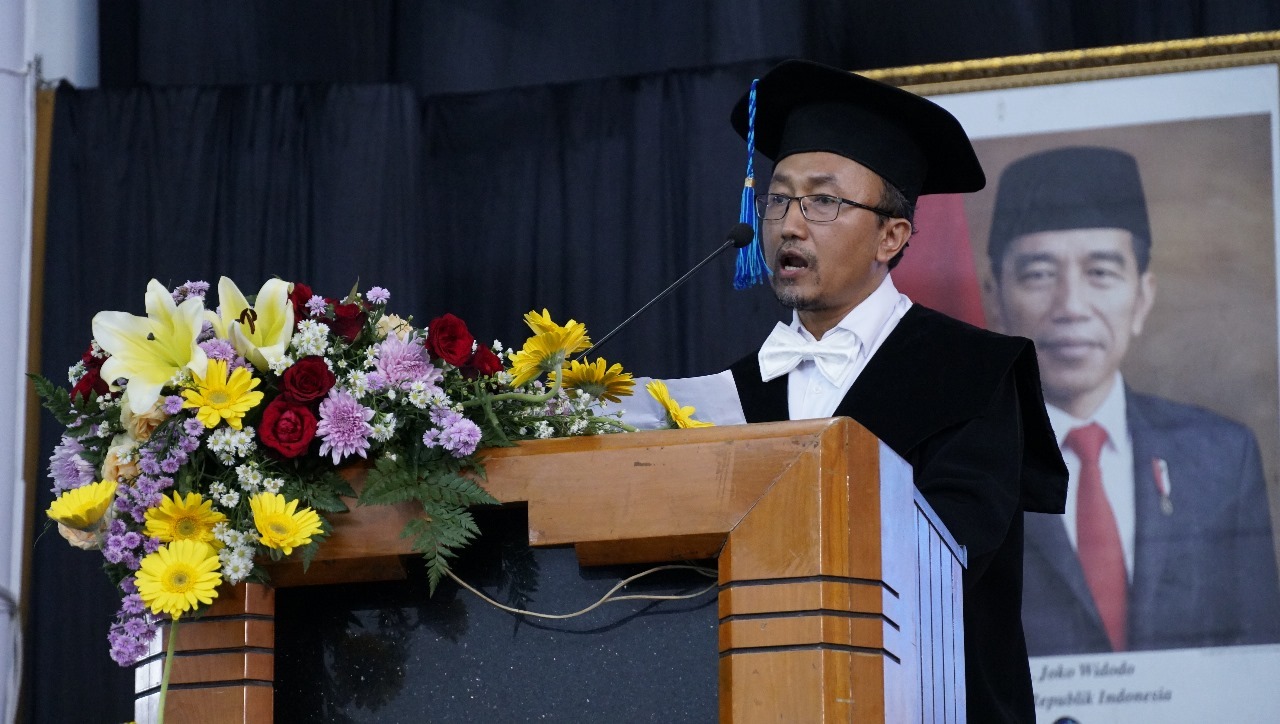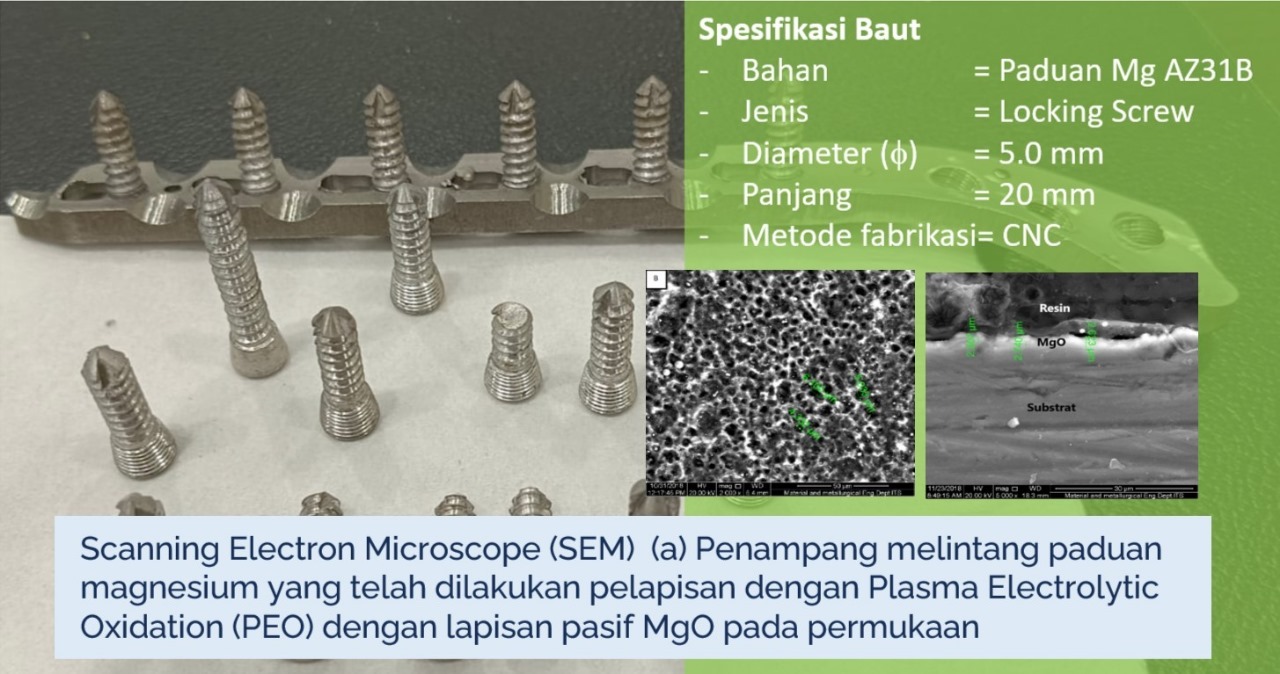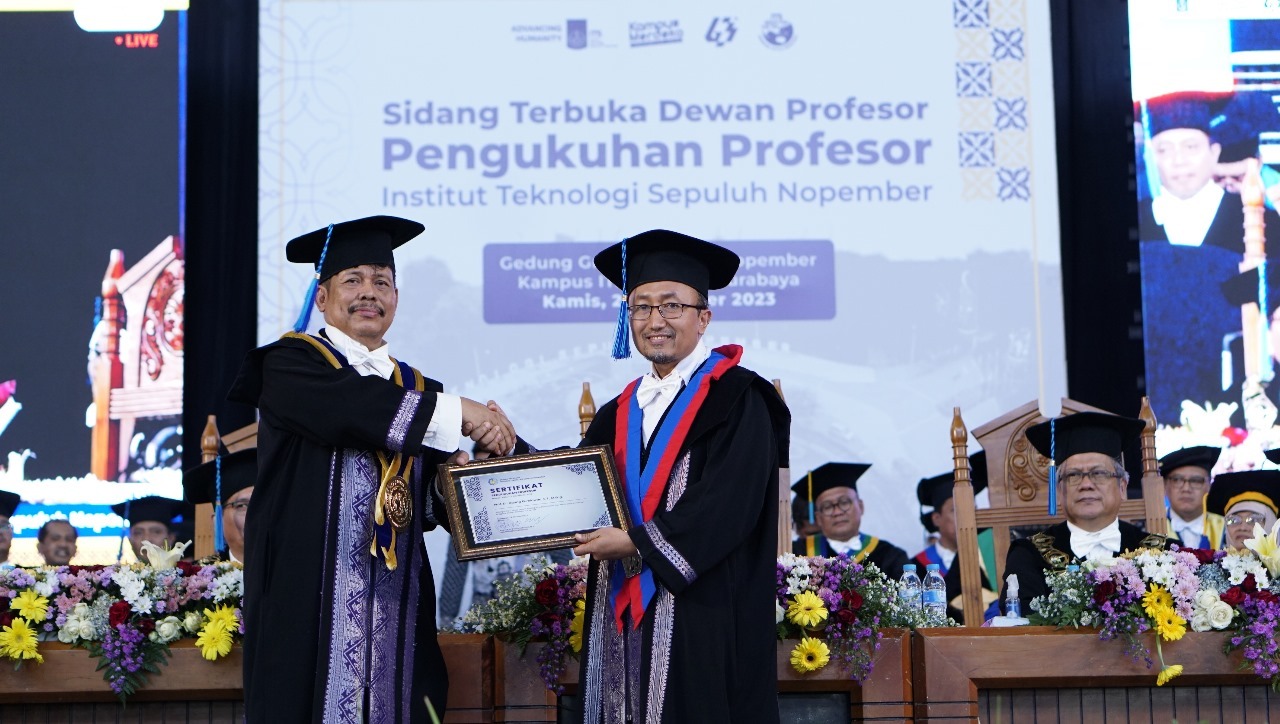ITS Professor Develops Biodegradable Implants for the World of Medicine

Prof Dr Agung Purniawan ST MEng from the ITS Department of Materials and Metallurgical Engineering as ITS’s 184th Professor when giving a scientific oration with his biodegradable implants research
ITS Campus, ITS News – In the field of orthopedics, healing of bone fractures commonly uses implants. The 184th Professor of Institut Teknologi Sepuluh Nopember (ITS) Prof Dr Agung Purniawan ST MEng developed implant material coatings to slow the rate of degradation and developed biodegradable bone implants materials.
Agung revealed that treatment for fractures commonly uses non-biodegradable materials such as stainless steel and titanium alloy. These two types of materials are often chosen because they have mechanical strength, resistance to corrosion, and do not react to body tissue. “However, after the new bone grows, it requires surgery to remove the implant which can present other risks,” explained the former Head of the ITS Materials and Metallurgical Engineering Department for 2019 – 2020.
To prevent this possibility, the use of biodegradable and bioabsorbable implants is another alternative. Its use can also speed up the healing process because it supplies the substances needed by the body. “Magnesium-based alloys are suitable because this substance is also needed by bones, but the rate of degradation is too fast,” he said.
The impact of this degradation can reduce the mechanical properties of the implant in bearing loads before new bone grows. Based on this, Agung developed surface engineering technology to control the rate of material degradation. “The Plasma Electrolytic Oxidation (PEO) method creates a passive layer which can reduce the rate of degradation by more than 90 percent compared to without treatment,” said the man who was born in Tulungagung, May 1976.

Scanning Electron Microscope from the results of coating using the Plasma Electrolytic method on bolts for implant needs researched by Prof. Agung Purniawan ST MEng
Not only that, this doctoral graduate from TU Delft, Netherlands is also researching the use of composite materials for biodegradable implants. This material is easier to manufacture and combines with other substances needed for bone growth. “Minerals or substances that are useful for the healing process are easier to incorporate into implants than metal alloys,” he explained.
Agung continued, this research was carried out to modify the chemical, physical and mechanical properties of this material. These include efforts to modify surface layers and interactions between material constituents. “The adhesive power of composite materials can be strengthened by adding the compound 3-aminopropyltriethoxysilane (APTES), thereby increasing its mechanical properties and service life,” added the man who currently serves as Head of the Subdirectorate of Scientific Research and Publications, Directorate of Research and Community Service (DRPM) ITS.

Prof. Agung Purniawan ST MEng (right) when receiving the certificate of inauguration as ITS’s 184th Professor by the Chair of the ITS Professorial Council Prof. Dr. Imam Robandi MT
Involved in various other research, this bespectacled man also contributed to the world of health through research into antimicrobial or antiviral coatings. The research he conducted used nano copper synthesis as an active substance mixed with an organic coating. “It has been scientifically proven that this coating can kill the SAR COV-2 virus up to 99 percent within one hour,” he explained.
This research itself has been included in the Scopus indexed Q1 journal and has also been applied in public facilities, especially during the COVID-19 pandemic. Some of them include the Airlangga University Hospital (RSUA), ITS Medical Center, One Roof Co-Working, and the G20 Electric Bus.
Looking to the future, Agung hopes that the research products of the ITS academic community can be welcomed by stakeholders and other researchers for development. Not only that, he also hopes that the use of the technology resulting from this biodegradable implants research can be applied to existing facilities on the ITS campus. “It would be proud if the portal system and waste processing could come from the work of ITS community members,” he said hopefully. (ITS Public Relations)
Reporter: Ricardo Hokky Wibisono
Translator: Nabila Aprilia
Related News
-
ITS Sends Off 12 Free Mudik Vehicles Ahead of Eid Al-Fitr
The dispatch of 11 bus fleets carrying ITS students for the Free Mudik ITS 2024 ITS Campus, ITS News
December 12, 2023 10:12 -
ITS Lecturer Wins 2024 Female Science Talents Intensive Tracks from Germany
Sri Fatmawati SSi MSc PhD, a lecturer at the Department of Chemistry, ITS, has emerged as the winner of
December 12, 2023 10:12 -
ITS Shares Tips & Tricks on SNBT 2024 Socialization
(from left) Executive Secretary of SNPMB 2024, Bekti Cahyo Hidayanto SSi MKom, Head of the Admissions Subdirectorate at ITS,
December 12, 2023 10:12 -
Supporting Defense in Indonesia, ITS Professor Creates Anti-Radar Material
Professor Dr. Mashuri SSi MSi, while delivering his academic oration on anti-radar materials during the ITS Professorial Inauguration. ITS
December 12, 2023 10:12
